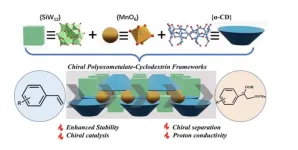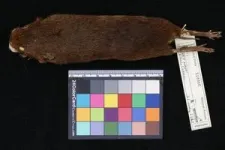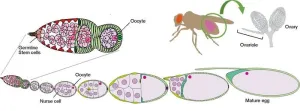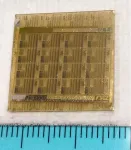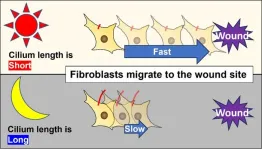A team of scientists has created a chiral assembly by blending inorganic polyoxometalates and organic cyclodextrin molecules. Polyoxometalates are a class of nanomaterials with many useful applications. But the use of polyoxometalates as building blocks to construct chiral POM-based frameworks has been a long-stranding challenge for researchers. In this research, the team produced a 3D framework, constructed by coordination assembly. The resulting framework features an interlaced organic-inorganic hybrid layer.
The team has published their work in the journal, Polyoxometalates, on December 18.
Polyoxometalates (POMs) are a class of nanomaterials with special features, that include high negative charges, notable redox abilities and available organic grafting. These useful features have led to POMs attracting much interest in energy-related applications. Their potential applications range from material science, catalysis, medicine, environmental protection, and hydrogen production. With their fascinating structural and chemical versatility, POMs are a recognizable choice in many fields of science, ranging from functional materials and catalysis to magnetism and biomedicine. When the POMs are used as building blocks to construct POM-based open frameworks, they have many advantages. These include robustness and intrinsic porosity. They can also be easily recycled.
Metal organic frameworks (MOFs) are a class of crystalline porous materials that are constructed from metal ions and organic bridging ligands. They are highly uniform porous structures that have large surface areas. MOFs, with their large specific surface area and permanent pores, have become outstanding candidates for loading POMs. When POMs and MOFs are combined, they form a kind of organic-inorganic hybrid material.
These POM and MOF hybrid materials are drawing a lot of interest among researchers, especially the chiral POM-based frameworks. Chiral in chemistry refers to mirror images. To describe a molecule as chiral is to say that its mirror image of itself is different. In the past, researchers have faced challenges in using POMs to create chiral POM-based frameworks. So the team focused their work on the application of POMs as building blocks in the construction of chiral POM-based functionalized frameworks. Chiral POM compounds have either extrinsic or intrinsic chirality, based on their chiral sources. The POM compounds’ chirality comes mainly from the chiral organic or organometallic parts. Intrinsically chiral POMs are POMs that are chiral due to symmetry breaking.
The research team was able to construct a chiral POM-based framework by blending inorganic POMs and organic cyclodextrin molecules. “As a robust chiral framework, the chiral separation and chiral catalysis have been explored,” said Cai-Hong Zhan, a professor at the College of Chemistry and Materials Science, Zhejiang Normal University. Cyclodextrins are a group of cyclic oligosaccharides that are produced from starch or starch derivatives. Because of their structure, they are good candidates to supplement the structure and improve the physiochemical properties of the MOFs.
The team connected {SiW12} anions, which are negatively charged ions, with manganese ions in an antiparallel manner. This formed a unique all-inorganic layer with significant voids. Then they combined it with an organic cyclodextrin layer that filled the voids in the POM-manganese layer. The two layers interweaved to form the organic-inorganic hybrid. They extended the layers with the sodium ion to produce a 3D framework.
The team used thermal cycling to explore the stability, chiral separation, chiral catalysis, and proton conductivity of the composite framework they had created. “The robust stability of this composite framework has been verified by thermal cycling experiments,” said Zhan
Looking ahead, the team plans to take this work further. “The chiral separation and chiral catalysis will be further explored by changing the substrate to prove that the chiral framework has potential applications,” said Zhan.
The research team includes Xiu-Xia Ding, Yun-Yue Yuan, Ya-Ge Zhang, Zhan-Guo Jiang, and Cai-Hong Zhan from the College of Chemistry and Materials Science, Zhejiang Normal University, Jinhua, China.
The research is funded by the National Natural Science Foundation of China, Natural Science Foundation of Zhejiang Province, and Zhejiang Normal University Fund.
About Polyoxometalates
Polyoxometalates is a peer-reviewed, international and interdisciplinary research journal that focuses on all aspects of polyoxometalates, featured in rapid review and fast publishing, sponsored by Tsinghua University and published by Tsinghua University Press. Submissions are solicited in all topical areas, ranging from basic aspects of the science of polyoxometalates to practical applications of such materials. Polyoxometalates offers readers an attractive mix of authoritative and comprehensive Reviews, original cutting-edge research in Communication and Full Paper formats, Comments, and Highlight.
About SciOpen
SciOpen is a professional open access resource for discovery of scientific and technical content published by the Tsinghua University Press and its publishing partners, providing the scholarly publishing community with innovative technology and market-leading capabilities. SciOpen provides end-to-end services across manuscript submission, peer review, content hosting, analytics, and identity management and expert advice to ensure each journal’s development by offering a range of options across all functions as Journal Layout, Production Services, Editorial Services, Marketing and Promotions, Online Functionality, etc. By digitalizing the publishing process, SciOpen widens the reach, deepens the impact, and accelerates the exchange of ideas.
END
